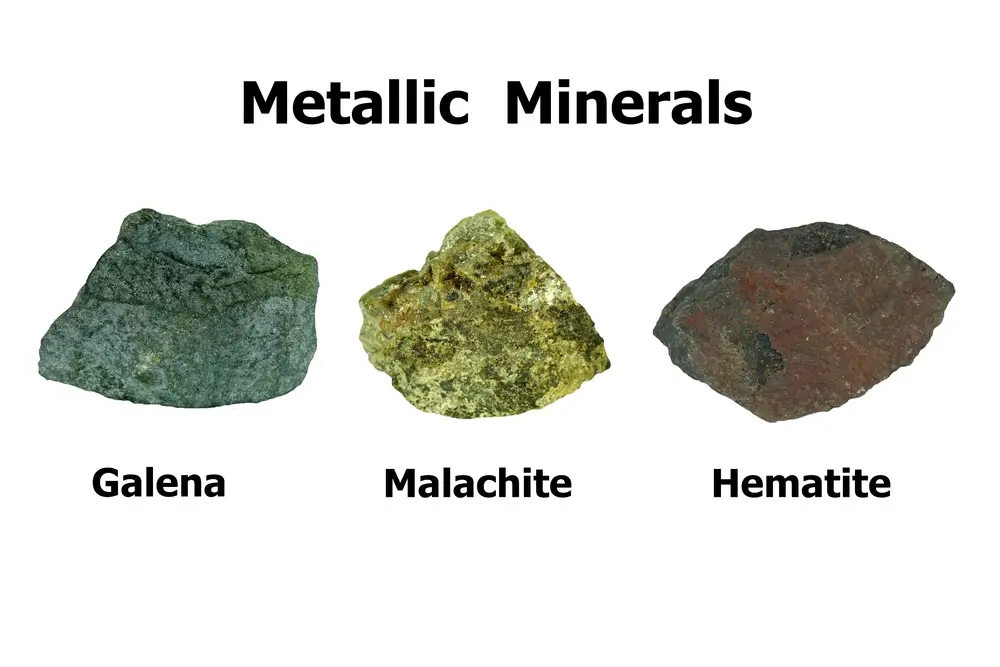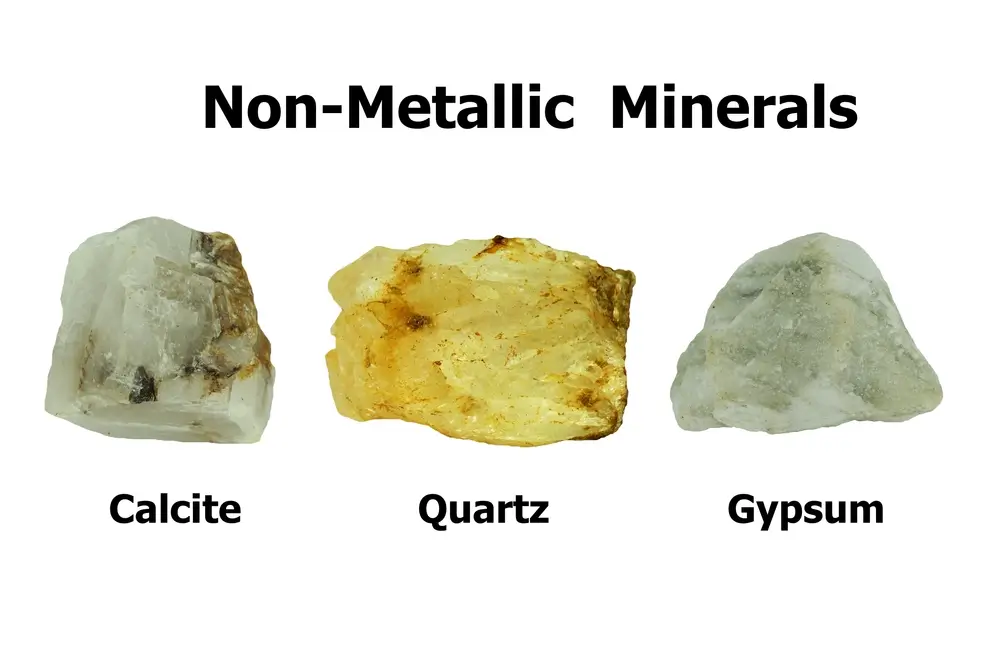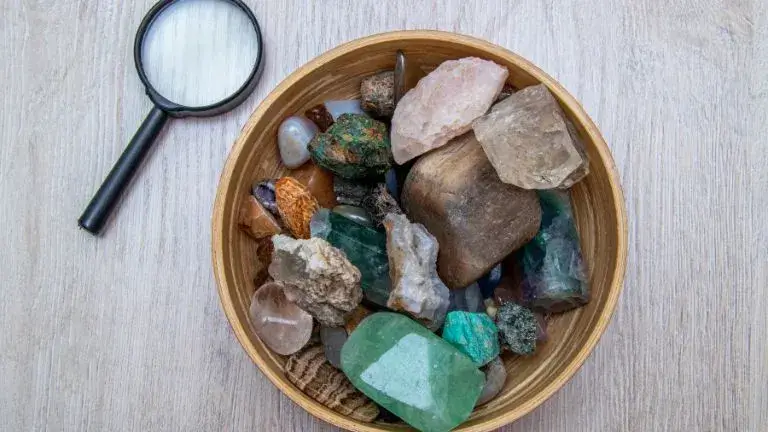The term “minerals” refers to the homogenous materials occurring naturally under various conditions and in many geological environments.
Minerals have distinct chemical structures, and their identification depends on their physical characteristics. An ore is a location where minerals can be found. Any mineral that is concentrated with other elements and is found in a certain location as rocks is called an ore.
On the basis of their composition, minerals can be divided into the following two types:
- Metallic Minerals
- Non-metallic Minerals
The difference between metallic and non-metallic minerals is that metal-containing minerals are those in which metals are found in their natural state. Non-metallic minerals, on the other hand, are those that are empty of metal.
Now let’s learn more about metallic and non-metallic minerals below:
Table of Contents
What are Metallic Minerals?

A metallic mineral has metal in its raw form. Thus, when one is found and discovered, it already contains material elements, to be specific in its composition.
The qualities of these include being strong conductors of heat and electricity, being typically quite hard, and having their own shine, which is a favorable characteristic.
These are found in igneous and metamorphic rocks and are typically found deeper in the earth than non-metallic minerals.
Characteristics of Metallic Minerals
- It includes metals in their raw form.
- They are usually hard and shiny.
- They are frequently found with igneous rocks.
Examples of Metallic Minerals
- Pyrite (iron)
- Chalcopyrite (iron, copper)
- Cuprite (copper)
- Argentite electrum (gold and silver)
Some of these metallic minerals, such as gold, silver, copper, and iron, are of enormous economic significance. Following extraction from. The ore is processed at a refinery or other facility to produce metal, which is then used to make ornaments, jewelry, weapons, instruments for a variety of uses, automobiles, and other things.
What are Non-Metallic Minerals?

Non-metallic minerals are minerals that are not often used as a source of raw materials for the extraction of metals. The non-metal group, which is present in a wide range of minerals, is very important economically.
Diamonds, mica, salt, potash, and other non-metallic minerals are a few examples. An example of a non-metallic mineral is the Kohinoor diamond, which is currently set in the queen of England’s crown.
Characteristics of Non-Metallic Minerals
- They are related to sedimentary rocks.
- They do not contain a raw form.
- They lack their luster and are soft.
Examples of Non-Metallic Minerals
- Quartz is a basic material for silicon and is used in oscillators and optical devices.
- Porcelain’s basic materials include feldspar.
- For abrasives, corundum (aluminum oxide) is utilized.
- Ceramics are produced using kaolinite.
- For electrical insulation, mica is utilized.
These are examples of non-metallic minerals.
Importance of Metallic and Non-Metallic Minerals
Metals are extracted as raw materials from metallic minerals and complexes. Since they contain metals in their purest form, they are very valuable. A few metallic minerals are bauxite, hematite iron ore, etc.
Metallic and hard minerals can be used as jewels in jewelry. The world’s numerous industries use a variety of materials for various purposes, including silicon in the computer industry, aluminum in the automobile and packaging sectors, and others.
Natural substances lacking metals are known as non-metallic minerals. Some examples of non-metallic minerals are potash, diamond, salt, mica, and others.
Limestone as a non-metallic mineral is widely used in the cement industry, mica is used in the microelectronics industry. Numerous industries and products can be produced using non-metallic resources. These can also be used to create reducing agents and nutrients.
Difference Between Metallic and Non-Metallic Minerals

There are many differences between metallic and non-metallic minerals given below:
The difference between metallic and non-metallic minerals is that metal elements can be found in the chemical composition of metallic minerals. Metal ores themselves can be classed as minerals. Iron, Copper, Gold, Silver, and others are some common metal minerals.
On the other hand, metal elements are absent from the inorganic chemical composition of non-metallic minerals. Clay, diamond, dolomite, gypsum, mica, amethyst, and quartz are a few typical examples.
Many of the physical characteristics of metals can be found in metallic minerals. They differ from non-metallic minerals in appearance, density, and hardness. For this reason, we refer to them as “metallic” minerals.
Non-metallic minerals lack a metallic appearance. They are a typical density of a rock. Their shine might be pearly, earthy, or glassy (appearance).
Metallic Vs. Non-Metallic Minerals
Minerals can either be metallic or non-metallic:
- In comparison between metallic vs. non-metallic minerals, metallic minerals contain metal elements in their natural state, whereas non-metallic minerals do not.
- Another difference between metallic and non-metallic minerals is that non-metallic minerals don’t typically have any shine or luster, but metallic minerals typically have luster.
- Metallic minerals are excellent heat and electricity conductors, whereas non-metallic minerals are excellent heat and electricity insulators.
- When metallic materials are melted, a new product is created, whereas non-metallic minerals do not produce a new product.
What are the Differences Between Metallic and Non-Metallic Minerals?
Highlighting the main differences between metallic and non-metallic minerals in the following table:
| Metallic Minerals | Non-Metallic Minerals |
|---|---|
| Metallic minerals are those that include metal elements in their unprocessed state. | Minerals classified as non-metallic don’t contain any metals. |
| A new substance is created when metallic minerals are melted. | Non-metallic minerals undergo such a process, but no new product is produced. |
| Typically, igneous and metamorphic rock formations contain metallic minerals. | Young fold mountains and sedimentary rocks frequently have non-metallic minerals contained inside them. |
| Metallic minerals are efficient heat and electrical conductors. | In general, non-metallic materials are effective heat and electricity insulators. |
| Metallic minerals are highly ductile and malleable. | Non-metallic minerals are readily brittle and lack ductility and malleability. |
Conclusion
In conclusion, the difference between metallic and non-metallic minerals is that metallic minerals are those that include metal components, whereas non-metallic minerals are those that do not.
By collecting metals from the metallic minerals, we may make vehicles, electrical wires, utensils, etc. Non-metallic minerals are typically found inside our bodies in the bones, teeth, cells, and other tissues.
The country’s natural resource, minerals, can be applied in numerous ways. Minerals are a finite and non-renewable resource since they take hundreds of years to collect and settle.
See more: What is the Difference Between Real Images and Virtual Images?


